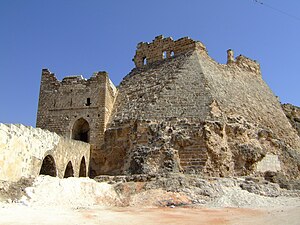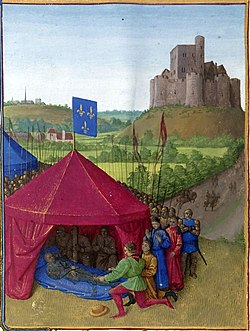Portal:Middle Ages
The Middle Ages portal
In the history of Europe, the Middle Ages or medieval period lasted approximately from the 5th to the late 15th centuries, similarly to the Post-classical period of global history. It began with the fall of the Western Roman Empire and transitioned into the Renaissance and the Age of Discovery. The Middle Ages is the middle period of the three traditional divisions of Western history: classical antiquity, the medieval period, and the modern period. The medieval period is itself subdivided into the Early, High, and Late Middle Ages.
Population decline, counterurbanisation, the collapse of centralized authority, invasions, and mass migrations of tribes, which had begun in Late Antiquity, continued into the Early Middle Ages. The large-scale movements of the Migration Period, including various Germanic peoples, formed new kingdoms in what remained of the Western Roman Empire. In the 7th century, North Africa and the Middle East—once part of the Byzantine Empire—came under the rule of the Umayyad Caliphate, an Islamic empire, after conquest by Muhammad's successors. Although there were substantial changes in society and political structures, the break with classical antiquity was not complete. The still-sizeable Byzantine Empire, Rome's direct continuation, survived in the Eastern Mediterranean and remained a major power. The empire's law code, the Corpus Juris Civilis or "Code of Justinian", was rediscovered in Northern Italy in the 11th century. In the West, most kingdoms incorporated the few extant Roman institutions. Monasteries were founded as campaigns to Christianise pagan Europe continued. The Franks, under the Carolingian dynasty, briefly established the Carolingian Empire during the later 8th and early 9th centuries. It covered much of Western Europe but later succumbed to the pressures of internal civil wars combined with external invasions: Vikings from the north, Magyars from the east, and Saracens from the south.
During the High Middle Ages, which began after 1000, the population of Europe increased greatly as technological and agricultural innovations allowed trade to flourish and the Medieval Warm Period climate change allowed crop yields to increase. Manorialism, the organisation of peasants into villages that owed rent and labour services to the nobles, and feudalism, the political structure whereby knights and lower-status nobles owed military service to their overlords in return for the right to rent from lands and manors, were two of the ways society was organized in the High Middle Ages.
This period also saw the collapse of the unified Christian church, with the East-West Schism of 1054. The Crusades, first preached in 1095, were military attempts by Western European Christians to regain control of the Holy Land from Muslims. Kings became the heads of centralised nation-states, reducing crime and violence but making the ideal of a unified Christendom more distant. Intellectual life was marked by scholasticism, a philosophy that emphasised joining faith to reason, and by the founding of universities. The theology of Thomas Aquinas, the paintings of Giotto, the poetry of Dante and Chaucer, the travels of Marco Polo, and the Gothic architecture of cathedrals such as Chartres are among the outstanding achievements toward the end of this period and into the Late Middle Ages.
The Late Middle Ages was marked by difficulties and calamities including famine, plague, and war, which significantly diminished the population of Europe; between 1347 and 1350, the Black Death killed about a third of Europeans. Controversy, heresy, and the Western Schism within the Catholic Church paralleled the interstate conflict, civil strife, and peasant revolts that occurred in the kingdoms. Cultural and technological developments transformed European society, concluding the Late Middle Ages and beginning the early modern period. (Full article...)
Selected article
Selected biography

Majd ad-Dīn Usāma ibn Murshid ibn ʿAlī ibn Munqidh al-Kināni al-Kalbi (also Usamah, Ousama, etc.; Arabic: أسامة بن منقذ) (July 4, 1095 – November 17, 1188) was a medieval Muslim poet, author, faris (professional warrior), and diplomat from the Banu Munqidh dynasty of Shaizar in northern Syria. His life coincided with the rise of several medieval Muslim dynasties, as well as the arrival of the First Crusade and the establishment of the crusader states.
He was the nephew of the emir of Shaizar and probably expected to rule Shaizar himself, but he was exiled in 1131 and spent the rest of his life serving other leaders. He was a courtier to the Burids, Zengids, and Ayyubids in Damascus, serving the famous Zengi, Nur ad-Din, and Saladin over a period of almost fifty years. He also served the Fatimid court in Cairo, as well as the Artuqids in Hisn Kayfa. He often meddled in the politics of the courts in which he served, and he was exiled from both Damascus and Cairo.
During and immediately after his life he was most famous as a poet and adib (a "man of letters"). He wrote many poetry anthologies, such as the Kitab al-'Asa ("Book of the Staff"), Lubab al-Adab ("Kernels of Refinement"), and al-Manazil wa'l-Diyar ("Dwellings and Abodes"), and collections of his own original poetry. For modern readers, however, he is most well known for his Kitab al-I'tibar ("Book of Learning by Example" or "Book of Contemplation"), which contains lengthy descriptions of the crusaders, whom he interacted with on many occasions, and some of whom he considered friends, although he generally saw them as ignorant foreigners.
Most of his family was killed in an earthquake at Shaizar in 1157. He died in Damascus in 1188, at the age of 93, a remarkably advanced age for the time. (Read more. . .)
Did you know...
- ...that a paillasse is a thin mattress filled with hay or sawdust and was commonly used in the middle ages?
- ...that a barbican is a tower or other fortification defending the drawbridge, usually the gateway?
- ...that a coif is a type of armored head-covering made out of chain-mail and worn under the helmet for extra protection?
- ...that a heriot is a payment owed to the lord of the manor by a serf’s family upon the serf’s death; usually the family’s best animal, such as a cow, horse or most commonly ox?
- ...that before 1066, it was noted in the Domesday Book, if one Welshman killed another, the dead man’s relatives could exact retribution on the killer and his family (even burning their houses) until burial of the victim the next day?
- ...that buboes are pus-filled egg-sized swellings of the lymph glands of the neck, armpits, and groin; typically found in cases of bubonic plague?
- ...that laws passed in the late 1300s aimed at maintaining class distinctions by prohibiting lower classes from dressing as if they belonged to higher classes?
- ...that Pier Gerlofs Donia, a 15th century Frisian freedom fighter of 7 feet tall was alleged to be so strong that he could lift a 1000 pound horse?
- ...that Edgar Ætheling was the last of the Anglo-Saxon Kings of England, but was only proclaimed, never crowned?
Selected image
Related portals
Subcategories
Topics
Medieval Armenia · History of Bosnia and Herzegovina (958–1463) · Bulgarian Empire · Britain in the Middle Ages · Byzantine Empire · Medieval Croatian state · Crusader states · History of the Czech lands in the Middle Ages · England in the Middle Ages · France in the Middle Ages · Germany in the Middle Ages · Italy in the Middle Ages · Kievan Rus′ · Poland in the Middle Ages · Portugal in the Middle Ages ·Romania in the Middle Ages · Scotland in the High Middle Ages · History of Medieval Serbia · Spain in the Middle Ages · Women in the Middle Ages · Kingdom of Hungary in the Middle Ages · Wales in the Middle Ages
Things you can do
 |
Here are some tasks awaiting attention:
|
WikiProjects
Associated Wikimedia
The following Wikimedia Foundation sister projects provide more on this subject:
-
Commons
Free media repository -
Wikibooks
Free textbooks and manuals -
Wikidata
Free knowledge base -
Wikinews
Free-content news -
Wikiquote
Collection of quotations -
Wikisource
Free-content library -
Wikiversity
Free learning tools -
Wiktionary
Dictionary and thesaurus











